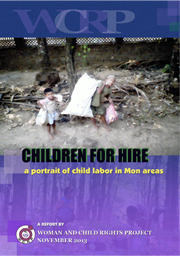Children for Hire: A Portrait of Child Labor in Mon Areas
By Woman and Child Rights Project • November 20, 2013 The growing domestic and international attention being paid to child labor in Burma, also known as Myanmar, signals a vital step in the country’s reform and development process. The advent of new funding to research the scope of the problem, proposed amendments to labor laws, and popularized documentaries exposing the lives of working children have indicated fresh interest in revealing and reducing the incidence of child labor.
The growing domestic and international attention being paid to child labor in Burma, also known as Myanmar, signals a vital step in the country’s reform and development process. The advent of new funding to research the scope of the problem, proposed amendments to labor laws, and popularized documentaries exposing the lives of working children have indicated fresh interest in revealing and reducing the incidence of child labor.
However, the catalyst for this report was sparked by observations that these proliferating activities and discussions are often largely restricted to urban areas, particularly regarding the well-known prevalence of Burma’s “teashop boys.” While urban forms of child labor warrant immediate and effective interventions, the ambiguity that shrouds less visible forms of the practice, especially occurring in rural ethnic villages and communities tucked against the country’s vast borderline, necessitates targeted illumination. During several interviews conducted for this report, civil society members and child protection officers described child labor in Burma as vastly under-researched, and said that accurate data from the country’s peripheral areas is almost nonexistent.
Almost half of the occurrences of child labor documented for this report were found in agricultural practices, primarily on rubber plantations and betel nut farms. An equivalent number of children interviewed were working in furniture factories, waiting tables or washing dishes in small restaurants, or searching garbage for recyclables to redeem. Others still were engaged as day laborers, piecing together daily wages by clearing weeds on plantations, gathering grasses to make brooms, or working as cowhands or woodcutters.
Income scarcity and food insecurity were central themes collected in many family narratives, but were also often rooted in other fundamental social issues. Poverty was not necessarily the sole cause of child labor, but rather the two were jointly symptomatic of poor access to education and healthcare, landlessness, migration, and the effects of decades of armed conflict and human rights abuses. Children, and particularly young girls, were also subject to social and gender norms that contributed to their entry into the workforce. The reduced likelihood that working children will complete their education and the increased risks associated with labor performed during children’s early developmental stages were found to feed directly back into these same family burdens that led to child labor.
In short, the many interconnecting social issues, economic and labor policies, and community histories surrounding child labor in rural areas are beyond the scope of this report to fully catalogue or evaluate. Instead, the research presented herein telescopes in on a very small but highly underreported area of child labor, and aims to amplify the voices and cast a light on the experiences of rural working children in Mon areas.
Tags: Child Rights, Children, Labor Rights, Woman and Child Rights ProjectThis post is in: Children and Youth, Human Rights, Spotlight
Related PostsCase Against Labour Rights Defender Draws International Outcry – Nearly 100 International Rights Groups Demand Industry Action
WCRP Releases “Children for Hire” to Mark Universal Children’s Day
BURMA: Abused Child Worker Who Seeks Justice Suffers Further Abuse in Courtroom
မစိုးရိမ္လာၿပီး ဝီရသူနားရြက္ကို တံေတြးစြတ္သြားသူ
Support for Rights of the Child and Human Rights in Myanmar









 All posts
All posts